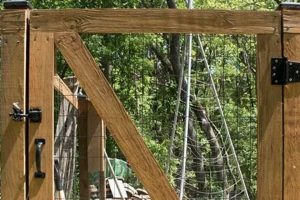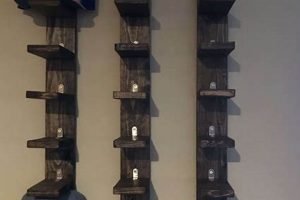The creation of an Advent wreath through do-it-yourself methods allows for a personalized and often more cost-effective approach to this traditional Christian symbol. This undertaking involves the selection of materials, the arrangement of candles representing hope, peace, joy, and love, and the construction of a circular base, typically from evergreen branches. An example would be gathering foliage from a backyard and arranging it around four candles secured within a repurposed tray.
Personalized Advent wreaths offer a tangible connection to the Advent season, promoting reflection and anticipation during the weeks leading up to Christmas. The crafting process itself can be a meaningful activity for families or individuals, fostering a sense of shared purpose and tradition. Historically, the Advent wreath has served as a visual reminder of the approaching celebration of Christ’s birth, its candles symbolizing spiritual light and the promises of faith.
The following sections will explore different methods for creating these personalized wreaths, detailing material selection, construction techniques, and variations on the traditional design.
Creating a Meaningful Advent Wreath
The following tips aim to guide individuals in constructing a personalized Advent wreath, ensuring a meaningful and aesthetically pleasing representation of the Advent season.
Tip 1: Material Selection: Choose evergreens that hold symbolic significance, such as fir for steadfastness or pine for remembrance. Consider the longevity of the greenery to ensure the wreath remains vibrant throughout the Advent season. Supplement natural materials with dried elements like berries or pinecones for added texture and visual appeal.
Tip 2: Candle Selection: Select candles of appropriate size and color to maintain visual harmony. Traditionally, three purple candles represent penance and preparation, one pink candle symbolizes joy, and a white candle is lit on Christmas Day to represent Christ. Ensure the candles are securely fastened to the wreath base to prevent accidents.
Tip 3: Base Construction: A sturdy base is crucial for stability. A grapevine wreath form, a metal ring, or even a repurposed platter can serve as the foundation. Secure greenery firmly to the base using floral wire or glue. Consider the overall size and proportions of the base in relation to the candles and decorative elements.
Tip 4: Candle Placement: Arrange the candles evenly around the wreath, maintaining consistent spacing. Avoid overcrowding to ensure proper airflow and prevent fire hazards. Consider using candle holders or spikes to provide additional support and stability.
Tip 5: Personalization: Incorporate personal touches that reflect individual faith or family traditions. This may include adding small ornaments, meaningful symbols, or scriptures. Ensure that these elements are tastefully integrated and do not detract from the overall symbolism of the Advent wreath.
Tip 6: Safety Precautions: Never leave a lit Advent wreath unattended. Keep flammable materials away from the flames. Ensure that the wreath is placed on a fire-resistant surface and away from drafts. Have a fire extinguisher or water nearby in case of emergency.
The adherence to these guidelines ensures a thoughtfully constructed Advent wreath that serves as a visual representation of the spiritual journey during the Advent season, enriching the anticipation of Christmas.
The subsequent sections will delve into the historical and symbolic significance of the Advent wreath, providing a deeper understanding of its enduring traditions.
1. Evergreen Symbolism
The incorporation of evergreen branches into a do-it-yourself Advent wreath is not merely decorative; it is fundamentally symbolic. Evergreen, by retaining its foliage throughout the winter months, represents eternal life, immortality, and the enduring nature of God’s promises. The selection of specific evergreen varieties can further enhance this symbolism. For example, fir branches may signify steadfastness and an upward gaze toward heaven, while pine branches might evoke remembrance and contemplation. The presence of these evergreens is a direct cause of the Advent wreath’s visual connection to themes of hope and unwavering faith.
Understanding evergreen symbolism is crucial in constructing a meaningful Advent wreath. A wreath created solely with artificial materials, while visually similar, lacks the inherent significance and spiritual connection provided by natural evergreens. The practical application of this understanding involves carefully selecting branches with healthy foliage, ensuring their longevity, and thoughtfully arranging them to emphasize their symbolic value. For instance, a sparse wreath might suggest a lack of faith, while a vibrant and abundant one could represent overflowing hope. The act of gathering or purchasing these materials can also become a contemplative practice, fostering a deeper connection to the Advent season’s message.
In summary, the presence of evergreens within a do-it-yourself Advent wreath provides a tangible representation of eternal life and enduring faith. A superficial approach that neglects evergreen symbolism diminishes the wreath’s potential to serve as a powerful visual reminder of Advent’s spiritual themes. Challenges may arise in sourcing fresh, high-quality evergreens, but the effort invested in selecting meaningful materials directly contributes to the creation of a more profound and personally resonant Advent symbol.
2. Candle Color Meaning
The selection and arrangement of candles within a do-it-yourself Advent wreath are governed by established color symbolism, each hue representing specific theological concepts. The traditional Advent wreath incorporates three purple candles, one pink candle, and often a central white candle. The purple candles signify penance, preparation, and anticipation, reflecting the season’s focus on spiritual reflection and readiness for Christ’s arrival. The pink candle, lit on the third Sunday of Advent, symbolizes joy and anticipates the imminent celebration of Christmas. The white candle, representing Christ’s purity and light, is traditionally lit on Christmas Day. The correct application of candle color meaning enhances the wreath’s ability to convey the essence of the Advent season.
Neglecting the established color symbolism diminishes the wreath’s didactic function. For example, using solely red candles, while visually appealing, would misrepresent the core themes of Advent, potentially confusing or misinforming those observing the tradition. Practical application involves a conscious selection of candles that adhere to the prescribed color scheme. Artisans crafting Advent wreaths for sale must also consider adherence to these traditional color associations to align with established religious customs. Furthermore, variations exist within traditions, such as s
ubstituting blue for purple, which should be thoughtfully considered and potentially explained when crafting the wreath. The cause of such symbolic use is rooted in the Christian liturgical calendar and associated practices, a connection which must be acknowledged when engaging with its material representation in the Advent wreath.
In summary, the precise use of color within the Advent wreath is not merely an aesthetic choice but a crucial element in conveying its intended theological message. A thorough understanding of candle color meaning is essential for creating a do-it-yourself Advent wreath that effectively communicates the themes of penance, preparation, joy, and the arrival of Christ. Challenges may arise in sourcing candles of specific colors or in understanding the nuances of differing traditions, yet the effort invested ensures a more meaningful and spiritually resonant Advent symbol.
3. Structural Stability
Structural stability is a foundational component of any do-it-yourself Advent wreath. It directly influences the wreath’s longevity, safety, and overall aesthetic appeal. A structurally unsound wreath risks collapse, creating a fire hazard from displaced candles or a disintegration of the decorative elements. The cause of structural instability often stems from inadequate base construction, insufficient securing of candles and greenery, or the use of inappropriate materials unable to withstand the wreath’s weight or environmental conditions. For example, a wreath utilizing a flimsy cardboard base and hot glue to secure heavy candles is inherently unstable. The practical significance of understanding structural principles in wreath construction is the prevention of accidents and the assurance of a lasting, visually pleasing symbol throughout the Advent season. Securing candles properly and using floral wire, not just glue, to secure items is critical.
Practical applications of structural stability principles include selecting a robust base material, such as a metal ring or a dense grapevine wreath. Equally crucial is the choice of securing methods. Floral wire offers a more secure and lasting hold than adhesive alone, particularly for attaching heavier elements like candles and substantial evergreen boughs. Consider the weight distribution when arranging components. Uneven weight can lead to tilting or collapse. In the case of tabletop wreaths, a flat, stable base is essential. For hanging wreaths, a strong and reliable hanging mechanism, such as a heavy-duty wire or cord, is paramount. The challenge lies in balancing aesthetic preferences with the need for a secure and long-lasting structure.
In summary, structural stability is not merely a technical consideration but an integral aspect of a functional and meaningful Advent wreath. By prioritizing structural integrity, crafters ensure the wreath serves its intended purpose safely and effectively throughout the Advent season. Addressing challenges, such as material sourcing and construction techniques, allows for the creation of a visually appealing symbol embodying the spiritual significance of Advent, without safety compromises.
4. Personalized Elements
The incorporation of personalized elements into a do-it-yourself Advent wreath elevates the project from a mere craft activity to a deeply meaningful expression of faith and tradition. The cause of this transformation lies in the ability of personalized elements to reflect individual or familial beliefs, memories, and aspirations, thereby fostering a more profound connection to the Advent season. The inclusion of specific ornaments, symbols, or scriptural verses transforms a generic wreath into a unique representation of personal spirituality. The practical significance rests in the wreath becoming a tangible reminder of individual faith journeys, serving as a focal point for reflection and prayer throughout Advent.
Examples of personalized elements encompass a wide range of possibilities. A family might incorporate ornaments representing deceased loved ones, transforming the wreath into a memorial, or include symbols reflecting their patron saint. Scriptural verses relevant to the season’s themes can be woven into the wreath’s design, providing daily inspiration. One family could use shells collected from a meaningful vacation to symbolize their journey and the blessings they received. Another may opt for handcrafted ornaments made by children, adding a layer of personal history and shared creativity. These additions augment the standard elements of the Advent wreath, creating a more meaningful and engaging experience for those observing the tradition. This individualized approach transforms a commercially available object into a family heirloom, carrying emotional and spiritual weight across generations.
In summary, personalized elements are an integral component of a meaningful do-it-yourself Advent wreath. They allow for the infusion of individual beliefs, memories, and aspirations, transforming the wreath into a unique representation of personal faith. Challenges may arise in selecting elements that resonate deeply and contribute harmoniously to the overall design, but the effort invested results in a more profound and spiritually resonant Advent symbol. The effect amplifies the purpose of the wreath.
5. Safety Measures
The construction and use of a do-it-yourself Advent wreath necessitate adherence to stringent safety measures, primarily due to the inclusion of open flames and combustible materials. These precautions mitigate the risk of fire and injury, ensuring a safe and spiritually enriching observance of the Advent season.
- Candle Stability and Placement
Candles must be securely affixed to the wreath to prevent tipping or dislodgement, which can ignite surrounding foliage. Appropriately sized candle holders or spikes should be used to anchor the candles firmly. Adequate spacing between candles and flammable materials, such as evergreen branches or ribbons, is essential to prevent ignition. For instance, candles positioned too close to dry foliage dramatically increase fire risk. Safe practice involves maintaining a buffer zone and trimming any overhanging greenery.
- Material Selection and Flame Retardancy
The choice of materials significantly impacts fire safety. Opt for inherently flame-resistant materials or treat combustible elements with a fire retardant spray. Avoid highly flammable items, such as dried flowers or lightweight fabrics, in close proximity to the candles. For example, applying a fire retardant to the evergreen branches of the wreath can significantly reduce the likelihood of ignition should a spark occur. Regular inspection of the wreath is advisable to ensure no materials have become dangerously dry and flammable.
- Supervision and Extinguishment
A lit Advent wreath should never be left unattended. Constant supervision is crucial to promptly address any potential hazards, such as a candle tipping or a spark igniting nearby materials. Candles should be extinguished completely before leaving the room or going to bed. A readily accessible fire extinguisher or water should be available in case of emergency. The application of this measure involves assigning a
designated person to monitor the wreath whenever the candles are lit and ensuring they possess the knowledge and resources to respond effectively to a fire. - Placement and Environment
The location of the Advent wreath impacts its safety. Place the wreath on a stable, heat-resistant surface away from drafts, curtains, and other flammable items. Avoid placing the wreath near walkways or in areas where it could be easily bumped or knocked over. For example, positioning the wreath on a stone or ceramic surface away from curtains reduces the risk of accidental ignition. This measure emphasizes awareness of the surroundings and proactive planning to minimize potential hazards.
The foregoing safety measures are integral to the responsible creation and use of a do-it-yourself Advent wreath. These proactive steps minimize the risk of fire and injury, allowing individuals and families to focus on the spiritual significance of the Advent season without compromising safety. Consistent adherence to these guidelines fosters a secure environment for observing this cherished tradition. Further examples would be adding a smoke detector or having a pre planned exit strategy.
Frequently Asked Questions
This section addresses common inquiries regarding the creation and proper use of Advent wreaths constructed through do-it-yourself methods. These answers aim to provide clear and concise guidance for individuals seeking to engage in this tradition with understanding and respect.
Question 1: What is the appropriate timing for constructing an Advent wreath?
The creation of the Advent wreath should ideally occur prior to the commencement of the Advent season, which begins four Sundays before Christmas. As such, constructing the wreath during the week preceding the first Sunday of Advent is considered timely.
Question 2: Are specific dimensions prescribed for an Advent wreath?
No standardized dimensions exist for an Advent wreath. The size is a matter of personal preference, contingent upon available space and aesthetic considerations. However, the wreath should be proportional, ensuring the candles are appropriately sized relative to the overall structure.
Question 3: Is adherence to the traditional color scheme mandatory?
While the traditional color scheme of three purple candles, one pink candle, and potentially a white Christ candle is prevalent, variations are permissible within certain denominations or personal interpretations. The symbolic significance of the colors should, however, be understood and respected.
Question 4: What constitutes an acceptable substitute for evergreen branches?
In situations where access to fresh evergreen branches is limited, artificial evergreen foliage may serve as a viable substitute. However, natural materials are generally preferred due to their inherent symbolism. Other options include using branches from other drought-resistant plants, such as boxwood, laurel or rosemary.
Question 5: What safety precautions are most critical when using a do-it-yourself Advent wreath?
The most critical safety precautions include ensuring candle stability, maintaining adequate spacing between candles and flammable materials, never leaving a lit wreath unattended, and placing the wreath on a heat-resistant surface away from drafts.
Question 6: How should the candles be arranged and lit during the Advent season?
Typically, one purple candle is lit on the first Sunday of Advent, with an additional purple candle lit on each subsequent Sunday. The pink candle is lit on the third Sunday of Advent, and the white candle, if present, is lit on Christmas Day.
The answers provided above represent general guidelines for creating and using Advent wreaths. Individual practices may vary based on denominational traditions and personal preferences.
The following section will explore alternative designs and modern interpretations of the traditional Advent wreath, offering creative options for those seeking to personalize this symbol of the Advent season.
diy advent wreath
The preceding discussion has explored various facets of the do-it-yourself Advent wreath, encompassing its construction, symbolic elements, safety considerations, and frequently encountered inquiries. Key areas of emphasis included the selection of meaningful materials, the adherence to traditional color symbolism, the prioritization of structural stability, the incorporation of personalized elements, and the rigorous implementation of safety measures. The examination has illustrated that the creation of such a wreath extends beyond a simple crafting exercise, serving as a tangible expression of faith and a visual reminder of the Advent season’s spiritual significance.
As individuals and families embark on the creation of their own Advent wreaths, a thoughtful and informed approach is encouraged. The synthesis of tradition and personal expression can result in a profound symbol that enriches the observance of Advent and deepens the anticipation of Christmas. Further exploration of liturgical resources and adherence to established safety protocols will ensure both the meaningfulness and the security of this cherished practice.







